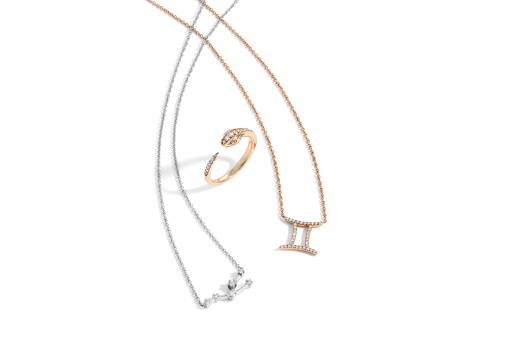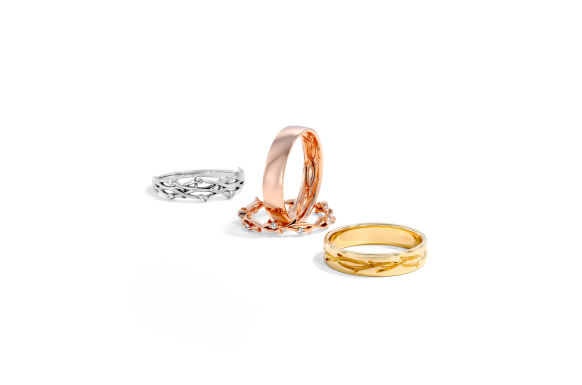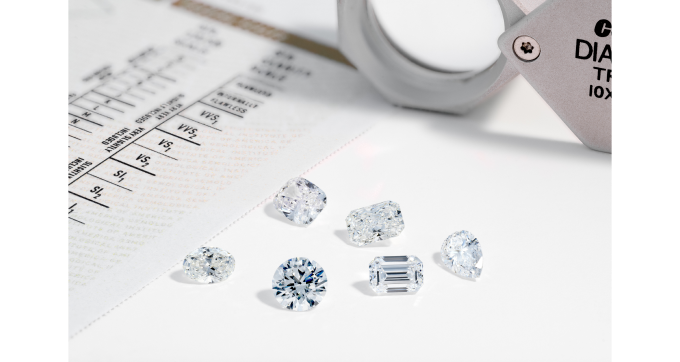For centuries, diamonds have been the default center stone for engagement rings. From Mary of Burgundy in the 15th century to Meghan Markle and Molly-Mae Hague today, millions of brides have said ‘Yes’ to a flawless diamond. However, there’s a new contender that's been turning heads: Moissanite.
As modern jewelry styles evolve, more and more couples find themselves weighing the merits of these two stunning gemstones. Moissanite looks a lot like a diamond, but there are some key differences, the most important of which is its sustainability. Its eco-friendliness has made it the stone of choice for engagement rings worn by Elizabeth Olsen, Iggy Azalea, Olivia Wilde, and Janel Parrish.
Although diamonds continue to be the sparkler of choice for most engagements, Moissanite is surging in popularity due to its beauty, sustainability, and affordable price point. Let’s take a closer look at both options and determine which one may be better for you.
How Are Moissanite and Diamonds Different?
At first glance, both Moissanite and diamonds have a captivating shimmer that has made them coveted choices for jewelry, especially engagement rings. Chances are that at first glance, inexperienced eyes won’t see much difference between them. But each stone has unique properties that can make one better than the other for you.
Moissanite is Eco-Friendly
The diamond industry has faced criticism over the years for certain mining practices, including environmental degradation and issues related to conflict diamonds or "blood diamonds." At Keyzar, we are committed to stopping the conflict diamond trade. We ensure that all of our diamonds are certified under the Kimberley Process, which is a trade regime aimed at removing conflict diamonds from the global supply chain.
In the quest for truly eco-conscious gemstones, Moissanite emerges as a standout choice. This dazzling stone is synthesized in labs, circumventing the extensive environmental impact typically associated with diamond mining. Its popularity has surged, largely due to its sustainable credentials.
Unlike the extraction of natural diamonds, which can disrupt habitats, cause soil erosion, and contribute to carbon emissions, the creation of Moissanite in controlled lab environments significantly reduces ecological footprint. The process is not only less invasive to the planet but also aligns with ethical standards, making it an ideal choice for environmentally conscious consumers. With Moissanite, one can enjoy the brilliance of a gemstone while embracing a commitment to sustainability and ethical responsibility.
You Get Better Pricing With Moissanite!
Moissanite emerges as a clear winner in terms of affordability. They look like diamonds but at a fraction of the cost. This makes it an excellent option for those seeking the diamond aesthetic without the hefty price tag.
Let's break down the numbers to see just how much you can save with Moissanite. For instance, a 1 carat round H-VS2 natural diamond typically costs around $5000. If you opt for a lab diamond of equal size, the price drops to about $1000. However, choosing Moissanite for the same size brings the cost down even further to an impressive $500!
Moreover, Moissanite allows for greater flexibility in terms of size. For example, while a 0.5-carat F-VVS2 natural diamond may cost around $1300, you can obtain a much larger, 3.5-carat Moissanite for slightly more. The difference in size is not just noticeable but truly eye-catching, allowing you to enjoy a more prominent and striking gemstone in your ring.
This significant price difference offers several advantages. With the money saved by choosing Moissanite, you can indulge in a more elaborate engagement ring design or select a higher-priced metal like platinum. In short, Moissanite offers a highly attractive and budget-friendly alternative to diamonds, allowing you to enjoy the splendor and allure of a stunning gemstone without straining your finances.
Moissanite Wins the Sparkle Sweepstakes!
Both Moissanite and diamonds are celebrated for their stunning sparkle. Diamonds exhibit a classic brilliance, reflecting white light, but Moissanite has a higher refractive index. This means that it can showcase a dazzling rainbow effect, especially under direct sunlight or specific lighting. While some prefer the more transparent and crystalline reflection of a diamond, Moissanite has a sparkly exuberance that’s hard to look away from.
Diamonds Are Harder- But Not By A Lot!
Okay, diamonds win here! On the Mohs scale, which measures the hardness of minerals, diamonds proudly sit at a 10, making them the hardest known mineral. Moissanite trails closely behind with a rating of 9.25, making it one of the hardest substances as well.
When choosing between Moissanite and diamonds, it's essential to consider not just the appearance and cost but also the ethical implications and personal values that resonate with you. Both stones have their unique appeal, ensuring that there's a perfect choice for everyone.
What Engagement Rings Work Well With Moissanites?
With its exceptional brilliance and affordability, Moissanite works beautifully with practically all engagement rings. Each of our designs highlights Moissanite's unique qualities, from its stunning brilliance to the affordability that makes it an excellent choice for an engagement ring.
The Ashley
The Ashley has a slender 1.5mm band that accentuates the size and sparkle of the Moissanite, making it a stunning focal point. The four delicate claw prongs not only secure the gem but also add to its low-profile, elegant silhouette. Its clean lines and modest geometry make the Moissanite's brilliance a central attraction, blending classic and modern elements seamlessly.
The Kamellie
The Kamellie has a refined, timeless design that’s perfect for Moissanite. From the top view, it presents as a graceful solitaire, but the hidden halo beneath the center stone adds an understated, luxurious sparkle that complements the Moissanite's fire. This ring design subtly elevates the center stone, making it ideal for those who appreciate both simplicity and a touch of luxury.
The Liv
The Liv is a three-stone ring featuring elegant tapered baguettes. The slender band and side baguettes not only elongate the finger but also amplify the size and radiance of the Moissanite. This design allows the Moissanite to shine brilliantly, capturing attention every time it captures the light.
The Charlotte
Sleek and stylish, The Charlotte is a bezel-set engagement ring. The sleek metal frame, subtly adorned with a strip of pave-set diamonds, enhances the Moissanite's radiance. The band's additional diamond accents provide a breathtaking backdrop, making a Moissanite in this setting practical for everyday wear while still exuding sophistication.
The Penelope
With its thin band and intricate detailing, The Penelope is ideal for a Moissanite center stone. The pave-set accents and micro diamonds in the bridge area add just enough flash to draw attention to the Moissanite's sparkle. The slender design also gracefully highlights the center stone, making it the star of the show.
Conclusion
Choosing the perfect gemstone for an engagement ring is more than just a matter of preference; it's a reflection of personal values, style, and budget. Diamonds, with their deep-rooted history and unyielding sparkle, have long symbolized eternal love. On the other hand, Moissanite offers both an ethereal sparkle and an eco-friendliness that is valued by so many couples today.
If you're looking to make an informed choice between these two mesmerizing gemstones, consider Keyzar as your trusted partner. With a commitment to ethical practices, Keyzar offers engagement rings with Moissanite or diamonds that are ethically mined or produced in a controlled environment. To learn more about your options and source the ring of your dreams, check out our engagement ring collection today!






